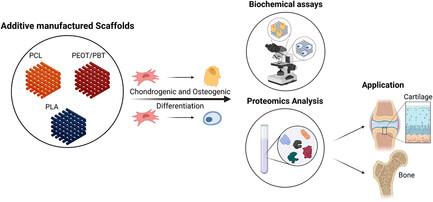A Proteomic Approach to Determine Stem Cell Skeletal Differentiation Signature on Additive Manufactured Scaffolds
IF 11.1
Q1 MATERIALS SCIENCE, MULTIDISCIPLINARY
引用次数: 0
Abstract
Understanding how porous biomaterials interact with cells at their surface and how they either promote or inhibit cellular processes has presented several challenges. Additive manufacturing enables the fabrication of scaffolds with distinct compositions and designs for different tissue engineering applications. To evaluate the in vitro performance of multiple printed materials, biochemical assays can be limiting in providing valuable insight and key information to select the best tissue destination. Omics technologies like proteomics are crucial for studying important cellular events and gathering valuable information about cellular processes and mechanisms. However, only few studies focus on proteomics to decipher cell–material interactions and cell differentiation on additive manufactured scaffolds. Here, scaffolds were fabricated using three polymers (polycaprolactone (PCL), poly(ethylene oxide)–poly(butylene terephthalate) (PEOT/PBT), and polylactic acid (PLA)) through additive manufacturing. Their chondrogenic and osteogenic potential were characterized and compared using human bone marrow-derived mesenchymal stem cells (hBMSCs) through proteomics analysis. The 3D scaffolds were all hydrophilic and displayed Young's moduli close to those of bone or cartilage for PLA and PCL and PEOT/PBT, respectively. Biochemical assays indicated that PEOT/PBT and PLA scaffolds have a greater chondrogenic potential by higher glycosaminoglycan (GAG) and collagen deposition compared to PCL. PLA and PEOT/PBT showed to be more effective in promoting bone formation, as evidenced by higher calcium deposits detected by alizarin red staining, and higher alkaline phosphatase (ALP), especially for PLA in osteogenic medium. Proteomics data revealed the most distinct separation between conditions in chondrogenic medium, which had the highest protein identification rates. Pathway analysis showed that PCL did not induce any differentiation-related pathways when compared to PEOT/PBT and PLA in any of the tested media conditions. Analysis of PEOT/PBT proteins showed pathways involved in chondrogenesis in all three media and pathways related to hypertrophic phenotype progression in chondrogenic medium. These data suggests that PEOT/PBT is a valuable candidate for cartilage and osteochondral applications, able to drive hBMSCs differentiation without the need of growth factors. PLA was also a valuable candidate for cartilage and bone applications by upregulating both chondrogenic and osteogenic-related proteins in maintenance and chondrogenic media. In osteogenic and maintenance media, the upregulation of angiogenic proteins makes PLA a better candidate for bone application where vascularization is key.

用蛋白质组学方法确定添加剂制造支架上的干细胞骨骼分化特征
了解多孔生物材料如何在其表面与细胞相互作用,以及它们如何促进或抑制细胞过程是一项挑战。增材制造技术可以制造出具有不同成分和设计的支架,用于不同的组织工程应用。要评估多种打印材料的体外性能,生化检测可以提供有价值的见解和关键信息,从而选择最佳的组织目的地。蛋白质组学等 Omics 技术对于研究重要的细胞事件以及收集有关细胞过程和机制的宝贵信息至关重要。然而,只有极少数研究关注蛋白质组学,以解读细胞与材料之间的相互作用以及添加剂制造的支架上的细胞分化。在这里,研究人员使用三种聚合物(聚己内酯(PCL)、聚环氧乙烷-聚对苯二甲酸丁二醇酯(PEOT/PBT)和聚乳酸(PLA))通过增材制造技术制作了支架。通过蛋白质组学分析,利用人体骨髓间充质干细胞(hBMSCs)对它们的软骨生成和成骨潜力进行了表征和比较。三维支架都具有亲水性,PLA、PCL 和 PEOT/PBT 的杨氏模量分别接近骨或软骨的杨氏模量。生化检测表明,与 PCL 相比,PEOT/PBT 和聚乳酸支架具有更高的糖胺聚糖(GAG)和胶原沉积,因而具有更大的软骨生成潜力。聚乳酸和 PEOT/PBT 在促进骨形成方面更有效,这体现在茜素红染色检测到的较高的钙沉积和较高的碱性磷酸酶(ALP),尤其是在成骨培养基中的聚乳酸。蛋白质组学数据显示,软骨培养基的蛋白质鉴定率最高,不同培养基之间的蛋白质分离最为明显。通路分析表明,与 PEOT/PBT 和 PLA 相比,PCL 在任何测试培养基条件下都不会诱导任何与分化相关的通路。对 PEOT/PBT 蛋白的分析表明,在所有三种培养基中,PCL 蛋白的通路都与软骨形成有关,而在软骨形成培养基中,PCL 蛋白的通路则与肥大表型进展有关。这些数据表明,PEOT/PBT 是软骨和骨软骨应用的重要候选材料,无需生长因子即可驱动 hBMSCs 分化。聚乳酸在维持培养基和软骨培养基中能上调软骨和成骨相关蛋白,因此也是软骨和骨应用的重要候选物质。在成骨和维持培养基中,血管生成蛋白的上调使聚乳酸成为骨应用的更佳候选物质,因为血管生成是骨应用的关键。
本文章由计算机程序翻译,如有差异,请以英文原文为准。
求助全文
约1分钟内获得全文
求助全文
来源期刊
CiteScore
14.00
自引率
2.40%
发文量
0
期刊介绍:
Small Science is a premium multidisciplinary open access journal dedicated to publishing impactful research from all areas of nanoscience and nanotechnology. It features interdisciplinary original research and focused review articles on relevant topics. The journal covers design, characterization, mechanism, technology, and application of micro-/nanoscale structures and systems in various fields including physics, chemistry, materials science, engineering, environmental science, life science, biology, and medicine. It welcomes innovative interdisciplinary research and its readership includes professionals from academia and industry in fields such as chemistry, physics, materials science, biology, engineering, and environmental and analytical science. Small Science is indexed and abstracted in CAS, DOAJ, Clarivate Analytics, ProQuest Central, Publicly Available Content Database, Science Database, SCOPUS, and Web of Science.

 求助内容:
求助内容: 应助结果提醒方式:
应助结果提醒方式:


